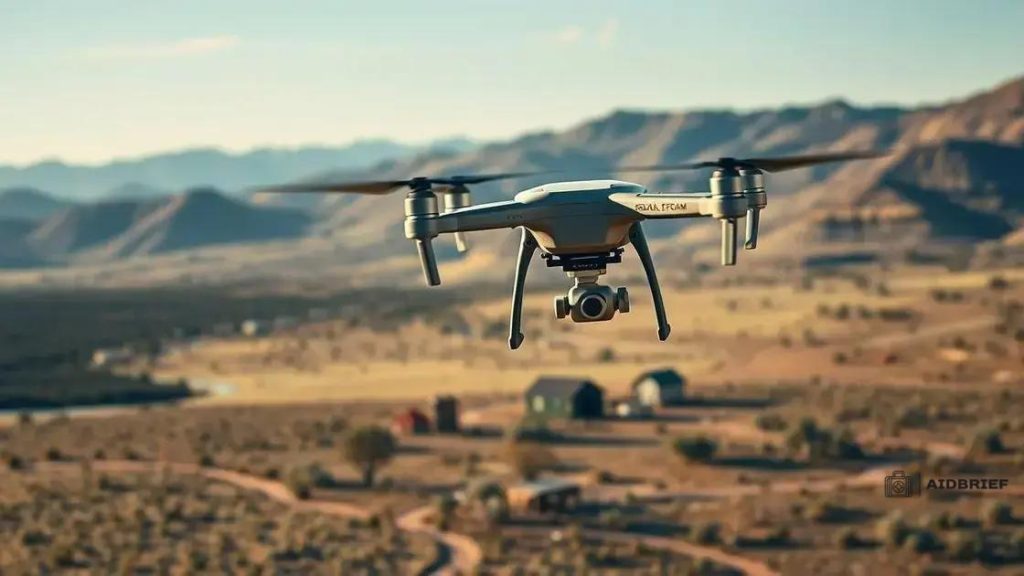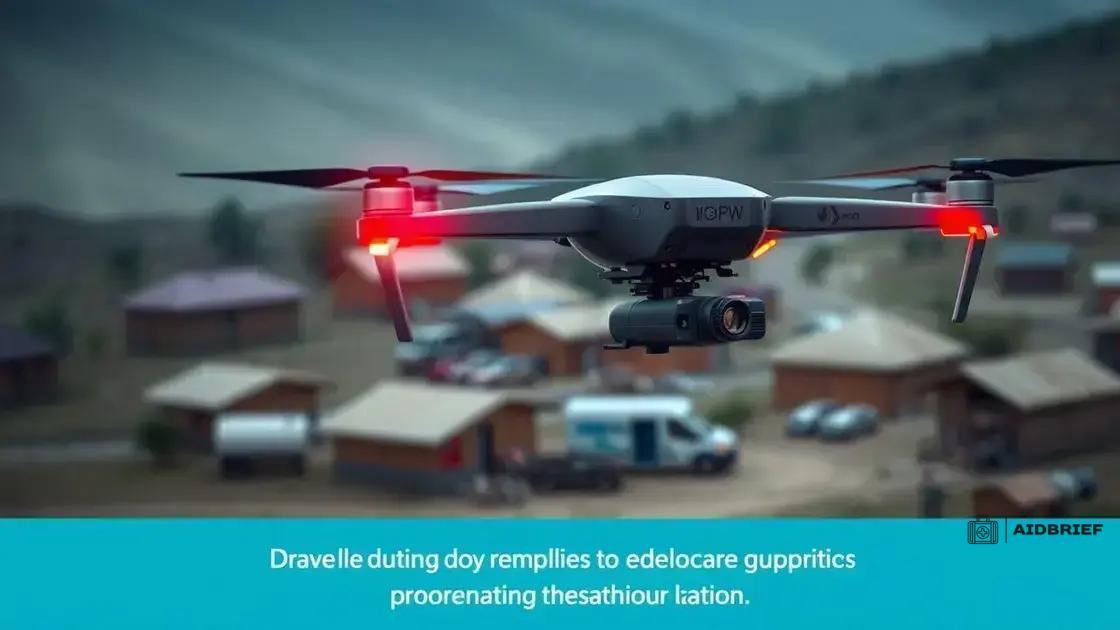Humanitarian drones delivering medical supplies to remote communities

Humanitarian drones are transforming healthcare delivery by providing quick access to medical supplies in remote communities, significantly improving health outcomes and increasing the efficiency of aid distribution.
Humanitarian drones delivering medical supplies in remote U.S. communities are transforming healthcare access, especially in areas often overlooked. Have you ever wondered how this technology works and the impact it has on lives?
The role of drones in healthcare delivery
The role of drones in healthcare delivery is becoming increasingly significant. These innovative devices are helping to reach areas that are often inaccessible, ensuring that medical supplies are delivered timely to those in need.
One of the primary advantages of using drones for healthcare is their speed. In emergencies, every second counts. Drones can cover vast distances quickly, making them an essential tool for urgent medical deliveries. They can transport blood, vaccines, and necessary medications directly to clinics and hospitals that may not have immediate access.
Advantages of drones in healthcare
Drones offer various benefits that enhance healthcare logistics. These include:
- Reduced delivery times in emergencies
- Lower operational costs compared to traditional delivery methods
- Access to remote or hard-to-reach locations
- Minimized human exposure to hazardous environments
Furthermore, drones are not just about speed. They also enhance the accuracy of deliveries. Equipped with GPS technology, they can pinpoint exact locations, ensuring that critical supplies reach their proper destination without delays.
The integration of drones into the healthcare system is showing promising results. Various pilots and projects across the country have demonstrated how effectively they can operate within existing medical frameworks. For example, in some rural areas, drones have successfully delivered vaccines and emergency supplies, significantly improving public health responses.
Challenges in drone healthcare delivery
Despite their many advantages, there are challenges that need addressing. These include:
- Regulatory restrictions and air traffic control
- Technology limitations, such as battery life and payload capacity
- Public acceptance and awareness
As the technology advances, many communities are beginning to see the potential of drones. Engaging local populations and informing them about the benefits can help ease concerns. The ongoing experiments and successful implementations are paving the way for drones to become a standard part of the healthcare delivery system.
Challenges faced by remote U.S. communities
Challenges faced by remote U.S. communities can significantly impact their access to essential services. These areas often struggle with issues like transportation, infrastructure, and healthcare. Understanding these challenges is crucial for finding effective solutions.
Many remote areas experience limited access to healthcare providers. Long distances to hospitals can deter people from seeking medical attention. This often leads to untreated conditions and worsening health outcomes. Additionally, transportation options may be scarce, making it difficult for residents to reach necessary services.
Key challenges for remote communities
Some major challenges include:
- Poor road conditions and lack of public transport.
- Limited internet and communication access.
- Shortage of healthcare professionals.
- Difficulty in obtaining medical supplies and emergency services.
Internet access is another critical issue. In many remote regions, connectivity is minimal or non-existent. This lack of access can hinder telehealth initiatives, preventing residents from receiving timely medical consultations. Furthermore, educational opportunities may also be compromised without reliable internet.
Moreover, the workforce in these communities can be significantly impacted by the absence of local job opportunities. Young people often leave in search of better prospects elsewhere, further diminishing the local population and straining services.
Community leaders are working hard to address these challenges, often focusing on collaboration and innovation. Programs aimed at improving infrastructure and health services are stepping up to make a difference. These efforts will require investment and commitment to transform the current landscape and enhance the quality of life for residents in remote U.S. communities.
Case studies of successful drone deliveries

Case studies of successful drone deliveries showcase the potential of drones in enhancing healthcare logistics. These real-life examples highlight how innovative technology can improve access to medical supplies and services, especially in remote areas.
One notable case is that of a remote community in North Carolina, where drones were used to deliver blood samples to testing facilities. Traditional transportation methods took too long, but with drones, samples were delivered in under 30 minutes. This prompt delivery significantly increased the chances of timely diagnoses.
Prominent case studies
Several successful projects illustrate the effectiveness of drone deliveries:
- Zipline in Rwanda: This company has been delivering blood and medical supplies to over 21 million people. Their service has saved countless lives by providing quick access to crucial supplies.
- UPS Flight Forward: In collaboration with CVS, this initiative has successfully delivered prescription medications to residential homes using drones, showcasing a practical application in urban logistics.
- Medic Mobile: In partnership with local health facilities, this program in Ghana utilized drones to transport vaccines and essential medicines to remote health posts. This project highlighted the efficiency of drones in reducing delivery time.
These success stories demonstrate that drones are not just a futuristic idea; they are currently being implemented and making a real difference. The use of drones has proven to reduce logistic costs and improve the speed of delivery, essential factors in healthcare.
Moreover, the ability to track deliveries in real-time enhances accountability and efficiency. As communities embrace this technology, the potential for drone use in healthcare continues to expand.
Technological advancements in drone logistics
Technological advancements in drone logistics are revolutionizing the delivery of medical supplies. These innovations are helping to make healthcare more efficient and accessible, especially in hard-to-reach areas.
One important advancement is the development of autonomous drones that can navigate without human intervention. These drones use sophisticated algorithms and sensors to find their way through complex environments. This means they can operate even in challenging weather conditions and during nighttime deliveries.
Key advancements impacting drone logistics
Some significant improvements in drone logistics include:
- Improved battery technology: Longer-lasting batteries enable drones to fly greater distances. This is crucial for reaching remote locations.
- Payload capacity: Enhanced designs allow drones to carry larger loads. This means more medical supplies can be delivered in a single trip.
- Advanced navigation systems: Drones are now equipped with GPS and GPS-denied navigation, making them reliable even in areas without cell service.
- Real-time tracking: Innovative software allows for live tracking of deliveries, helping recipients know exactly when to expect their items.
With these advancements, drones can perform complex tasks, such as avoiding obstacles and returning to base when low on battery. This level of autonomy increases reliability and efficiency, making them a preferred solution for healthcare delivery.
Another exciting development is the use of artificial intelligence (AI) in optimizing delivery routes. AI tools can analyze various factors, such as traffic, weather, and delivery urgency, to determine the fastest and safest routes for drones.
Moreover, some companies are exploring the integration of drone technology with other modes of transportation to create hybrid delivery systems. This could lead to even quicker service and better coverage in rural areas.
Future prospects for humanitarian drone use
The future prospects for humanitarian drone use look very promising. As technology continues to advance, drones are expected to play an even larger role in delivering essential medical supplies and aid to remote areas.
With ongoing improvements in battery life and payload capacity, drones will be able to carry heavier loads over longer distances. This means they can deliver more supplies in a single trip, which is crucial in emergencies. In addition, the development of advanced navigation systems and artificial intelligence will enhance their reliability and efficiency.
Potential future applications of drones
Humanitarian drones may soon be used for various purposes, including:
- Emergency response: Drones can be deployed quickly during disasters, delivering medical aid and supplies to affected areas faster than traditional methods.
- Routine health services: Regular deliveries of vaccines and medications to remote clinics can improve healthcare access and outcomes.
- Data collection: Drones can gather valuable data for health organizations, aiding in disease surveillance and outbreak management.
- Supply chain integration: Integrating drones into existing logistics systems can streamline operations and reduce costs.
Moreover, as regulations evolve, many more regions will become accessible for drone operations. Increased collaboration among governments, NGOs, and tech companies is vital for expanding the capabilities of drones in humanitarian efforts. This collaboration can lead to the establishment of standardized protocols for safe and effective drone deliveries.
Community engagement will also be key in the future of humanitarian drone use. Educating communities about the benefits of drones will foster acceptance and support for these technologies.
Overall, the integration of drones into humanitarian efforts is set to transform how aid is delivered, making it faster, safer, and more efficient, ultimately saving lives and improving health outcomes.
FAQ – Frequently Asked Questions about Humanitarian Drones
What are humanitarian drones used for?
Humanitarian drones are used for delivering medical supplies, vaccines, and essential aid to remote and hard-to-reach areas.
How do drones improve healthcare access?
Drones reduce delivery times, ensuring that medical supplies reach those in need faster than traditional methods.
What technological advancements are being made in drone logistics?
Improvements include better battery life, increased payload capacity, and enhanced navigation systems to ensure safe and efficient deliveries.
How can communities support the use of drones?
Community engagement and education about the benefits of drones are crucial for gaining support and ensuring successful implementation of drone programs.





